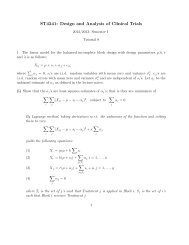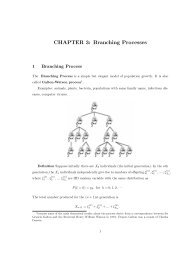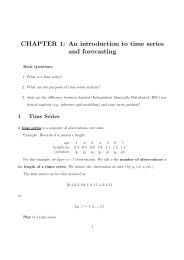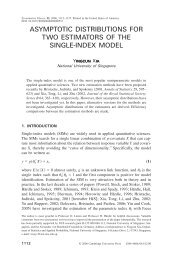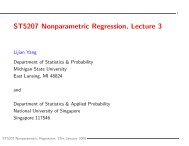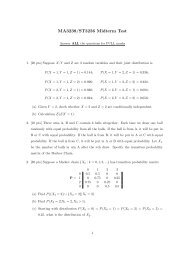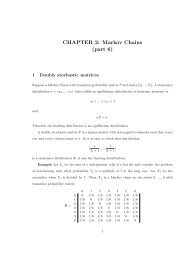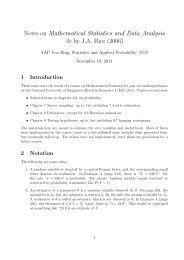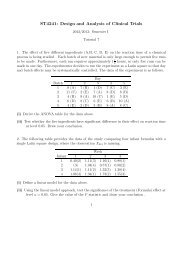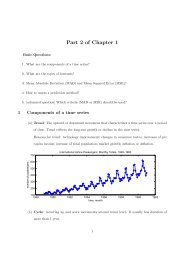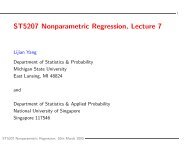Chap 2
Chap 2
Chap 2
Create successful ePaper yourself
Turn your PDF publications into a flip-book with our unique Google optimized e-Paper software.
ST4233, Linear Models, Semester 1 2008-2009<br />
Ch2. Random Vectors and Matrices<br />
1 Definition<br />
Definition 1.1 A random vector or random matrix is a vector or matrix whose elements<br />
are random variables.<br />
In formally, a random variable is defined as a variable whose value depends on the outcome<br />
of a chance experiment. (Formally, a random variable is a function defined for each element of<br />
a sample space.)<br />
In terms of experimental structure, we have two kinds of random vectors:<br />
1. A vector containing a measurement on each of n different individuals or experimental<br />
units. When the same variable is observed on each of n units selected at random, the n<br />
random variables y 1 , y 2 , · · · , y n in the vector are typically uncorrelated and have the same<br />
variance.<br />
2. A vector consisting of p different measurements on one individual or experimental unit.<br />
The p random variables thus obtained are typically correlated and have different variables.<br />
2 Means, Variances, Covariances, and Correlations (univariate)<br />
Let f(y) denote the density of the random variable y, the mean or expected value of y is defined<br />
as<br />
µ = E(y) =<br />
In general, for a function u(y), we have<br />
E[u(y)] =<br />
∫ ∞<br />
∫ ∞<br />
−∞<br />
−∞<br />
yf(y)dy.<br />
u(y)f(y)dy.<br />
A variance of a random variable y is defined as<br />
σ 2 = var(y) = E(y − µ) 2 .<br />
A square root of the variance is called the standard deviation,<br />
σ = √ var(y) = √ E(y − µ) 2 .<br />
For any two variables y i and y j , the covariance is<br />
σ ij = cov(y i , y j ) = E[(y i − µ i )(y j − µ j )].<br />
1
To standardize σ ij , we divide it by (the product of) the standard deviations of y i and y j to<br />
obtain the correlation<br />
ρ ij = corr(y i , y j ) = σ ij<br />
σ i σ j<br />
.<br />
The random variable y i and y j are said to be independent if their joint density factors into<br />
the product of their marginal densities:<br />
where the marginal density f i (y i ) is defined as<br />
f(y i , y j ) = f i (y i )f j (y j ),<br />
f i (y i ) =<br />
∫ ∞<br />
−∞<br />
f(y i , y j )dy j .<br />
The independence implies the following two properties:<br />
1. E(y i y j ) = E(y i )E(y j ) if y i and y j are independent.<br />
2. σ ij = cov(y i , y j ) = 0 if y i and y j are independent.<br />
Note that the converse of the second property is not true in general; that is, σ ij<br />
not imply independence.<br />
distribution.<br />
= 0 does<br />
It is only true in the case that y i and y j have a bivariate normal<br />
3 Mean Vectors and Covariance Matrices for Random Vectors<br />
3.1 Mean vector<br />
⎛ ⎞ ⎛ ⎞ ⎛ ⎞<br />
y 1 E(y 1 ) µ 1<br />
y 2<br />
E(y 2 )<br />
µ 2<br />
E(y) = E<br />
=<br />
=<br />
= µ,<br />
⎜<br />
⎝ . ⎟ ⎜<br />
⎠ ⎝ . ⎟ ⎜<br />
⎠ ⎝ . ⎟<br />
⎠<br />
y p E(y p ) µ p<br />
where E(y i ) = µ i .<br />
For the mean vectors, we have<br />
E(x + y) = E(x) + E(y).<br />
By analogy with E(y), we define the expected value of a random matrix Z as the matrix of<br />
expected values:<br />
⎛<br />
⎞ ⎛<br />
⎞<br />
z 11 z 12 · · · z 1p E(z 11 ) E(z 12 ) · · · E(z 1p )<br />
z 21 z 22 · · · z 2p<br />
E(z 21 ) E(z 22 ) · · · E(z 2p )<br />
E(Z) = E<br />
=<br />
⎜<br />
⎝ . . . ⎟ ⎜<br />
⎠ ⎝ . .<br />
. ⎟<br />
⎠<br />
z n1 z n2 · · · z np E(z n1 ) E(z n2 ) · · · E(z np )<br />
2
3.2 Covariance Matrix<br />
⎛<br />
⎞<br />
σ 11 σ 12 · · · σ 1p<br />
E[(y − µ)(y − µ) ′ σ 21 σ 22 · · · σ 2p<br />
] =<br />
= Σ,<br />
⎜<br />
⎝ . . . ⎟<br />
⎠<br />
σ p1 σ p2 · · · σ pp<br />
where σ ii = var(y i ) and σ ij = cov(y i , y j ).<br />
3.3 Generalized Variance<br />
A measure of overall variability in the population of y’s can be defined as the determinant of Σ:<br />
Generalized<br />
variance = |Σ|.<br />
If |Σ| is small, the y’s are concentrated closer to µ than of |Σ| is large. A small value of |Σ| may<br />
also indicate that the variables y 1 , y 2 , · · · , y p in y are highly intercorrelated, in which case the<br />
y’s tend to occupy a subspace of the p dimensions.<br />
3.4 Standardized Distance<br />
To obtain a useful measure of distance between y and µ, we need to take into account the<br />
variance and covariance of the y i ’s in y. The standardized distance is defined as<br />
Standardized distance = (y − µ) ′ Σ −1 (y − µ).<br />
This distance is often called a Mahalanobis distance.<br />
3.5 Correlation Matrices<br />
The correlation matrix is defined as<br />
⎛<br />
⎞<br />
1 ρ 12 · · · ρ 1p<br />
ρ 21 1 · · · ρ 2p<br />
P ρ = (ρ ij ) =<br />
,<br />
⎜<br />
⎝ . . . ⎟<br />
⎠<br />
ρ p1 ρ p2 · · · 1<br />
where ρ ij = σ ij /[σ i σ j ]. If we define<br />
D σ = diag(σ 1 , σ 2 , · · · , σ p ),<br />
we have<br />
and<br />
P ρ = D −1<br />
σ ΣD −1<br />
σ ,<br />
Σ = D σ P ρ D σ .<br />
3
4 Linear Functions of Random Vectors<br />
4.1 Means<br />
Theorem 4.1 If a is a p × 1 vector of constants and y is a p × 1 random vector with mean<br />
vector µ, then the mean of z = a ′ y is given by<br />
µ z = E(a ′ y) = a ′ E(y) = a ′ µ.<br />
Theorem 4.2 Suppose y is a random vector, X is a random matrix, a and b are vectors of<br />
constants, and A and B are matrices of constants. Then, assuming the matrices and the vectors<br />
in each product are conformable, we have the following expected values:<br />
(a) E(Ay) = AE(y).<br />
(b) E(a ′ Xb) = a ′ E(X)b,<br />
(c) E(AXB) = AE(X)B.<br />
4
4.2 Variances and Covariances<br />
Theorem 4.3 If a is a p×1 vector of constants and y is a p×1 random vector with covariance<br />
matrix Σ, then the variance of z = a ′ y is given by<br />
σz 2 = var(a ′ y) = a ′ Σa.<br />
Corollary 4.1 If a and b are p × 1 vectors of constants, then<br />
cov(a ′ y, b ′ y) = a ′ Σb.<br />
Theorem 4.4 Let z = Ay and w = By, where A us a k × p matrix of constants, B is an<br />
m × p matrix of constants, and y is a p × 1 random vector with covariance matrix Σ. Then<br />
(a) cov(z) = cov(Ay) = AΣA ′ ,<br />
(b) cov(z, w) = cov(Ay, By) = AΣB ′ .<br />
5



